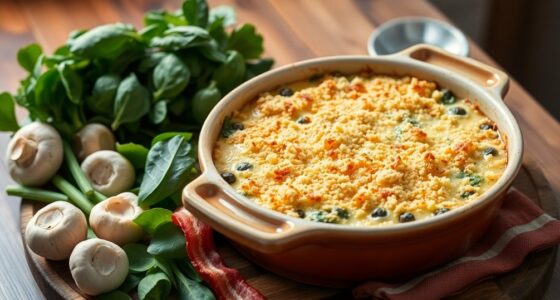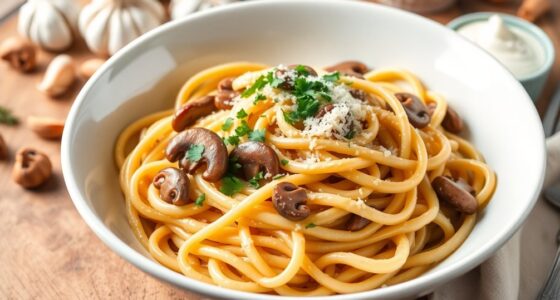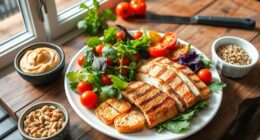Leberkäse, often called "meat bread," is a savory German dish that features a delicious blend of ground beef, pork, and bacon. It's traditionally baked in a loaf pan, giving it a smooth texture and rich flavor. You can enjoy it warm with mustard or cold alongside potato salad or pretzels. Variants like Käseleberkäse with cheese or Zwiebelleberkäse with onions show its versatility. There's so much more to discover about this beloved dish and how to make it!
History

Leberkäse, which means "liver cheese," actually has its roots in Bavaria, Germany, where it emerged in the mid-1700s as a clever way to make use of leftover meats.
The name might suggest liver as a key ingredient, but it actually refers to the old German word "Laib," meaning loaf, highlighting its shape instead.
Traditionally, you'd find a mixture of finely ground beef, pork, and sometimes pork liver, all seasoned and baked to create a delicious crust.
Over the years, regional variations like Käseleberkäse and Zwiebelleberkäse have popped up, adding cheese and onions to the mix.
Today, Leberkäse is a beloved street food in Southern Germany and Austria, often enjoyed at butcher shops and festivals. Proper diet is essential for maintaining health and taste in various meat dishes, including Leberkäse.
Recipe

Leberkäse, often referred to as "meat bread," is a traditional German dish that's both hearty and versatile. This delightful loaf combines ground beef, pork, and a touch of pork belly or bacon to create a savory treat that can be enjoyed warm or cold.
Whether served in thick slices with mustard and pickles or as part of a larger meal with potato salad and soft pretzels, Leberkäse promises to be a crowd-pleaser at any gathering.
To create the perfect Leberkäse, it's essential to achieve a smooth and well-blended meat mixture, which is best accomplished using a food processor. The addition of ice cubes during blending helps maintain the right temperature, preventing fat from separating.
Once baked to golden perfection, the loaf not only looks appealing but also delivers a satisfying flavor that makes it a beloved dish in many households. Including balanced protein in your meals can further enhance your dietary benefits.
Ingredients:
- 600g ground beef
- 400g ground pork
- 100g pork belly or bacon
- 1-2 tsp kosher salt
- White ground pepper (to taste)
- Marjoram (to taste)
- Ice cubes (as needed)
Cooking Instructions:
Begin by combining the ground beef, ground pork, and pork belly or bacon in a food processor. Add the kosher salt, white ground pepper, and marjoram, then blend the mixture for at least one hour, incorporating ice cubes as necessary to keep the mixture cool.
Once blended into a smooth consistency, transfer the mixture into a greased loaf pan, pressing it down firmly to eliminate any air bubbles. Use a wet spatula to create a decorative diamond pattern on the top.
Preheat your oven to 350°F (180°C) and bake the loaf for 40 minutes to 1 hour, checking for a golden-brown crust and your desired texture. Once baked, allow it to cool slightly before slicing.
Extra Tips:
For the best flavor, consider experimenting with different seasonings beyond marjoram, such as thyme or nutmeg, to tailor the dish to your taste.
It's also important to ensure that the meat mixture is packed tightly into the loaf pan to avoid any air pockets that could affect the texture. If you prefer a crispier crust, you can broil the loaf for a few minutes at the end of the baking time.
Finally, Leberkäse can be stored in the refrigerator for several days, making it a convenient option for meal prep or quick snacks throughout the week. Enjoy!
Cooking Steps

To get started on your Leberkese, preheat your oven to 350°F.
Next, mix the meat and spices thoroughly, ensuring every bite is packed with flavor.
Once you shape it into a loaf, chilling it in the fridge will help it hold together better during baking. Additionally, consider serving it with a side of Cheesy Polenta to complement the flavors of the meat.
Step 1. Preheat Oven to 350°F

Preheating your oven to 350°F (180°C) is crucial for achieving the perfect Leberkäse. A properly preheated oven ensures even cooking and helps develop that crunchy brown crust you're looking for. To enhance the overall experience, consider incorporating aesthetic enhancements such as fresh herbs or spices into your Leberkäse mixture for added flavor and visual appeal.
Before you start, make sure your loaf pan is prepared with cooking spray or lined with parchment paper to prevent sticking during the baking process.
Once your oven reaches 350°F, you're ready to bake. Keep an eye on your Leberkäse; check for doneness after 40 minutes, as cooking times can vary based on your oven performance and the size of your loaf.
After baking, let the Leberkäse rest for a few minutes to maintain its shape when slicing. Enjoy the delicious results of your efforts!
Step 2. Mix Meat and Spices Thoroughly

Start by blending the meats to create a smooth and cohesive mixture.
Use a food processor to combine 600g of finely ground beef, 400g of ground pork, and 100g of pork belly or bacon. Mix until you achieve a smooth consistency.
While blending, add 1-2 teaspoons of kosher salt and 1 teaspoon of white ground pepper to enhance the flavor profile of your Leberkäse.
To maintain a fine texture, gradually incorporate 500g of ice into the mixture.
If you want to personalize the flavor, mix in optional seasonings like marjoram or paprika, ensuring they're evenly distributed.
Finally, press down the mixture into loaf pans to remove air bubbles, which will help achieve a uniform texture during baking. Including chia seeds in your diet can offer additional nutritional benefits, such as high omega-3 content.
Step 3. Shape Into a Loaf

Begin shaping your Leberkäse by preparing a loaf cake pan—either spray it with cooking spray or line it with parchment paper to prevent sticking.
Next, pack the Leberkäse mixture firmly into the prepared pan. Press down to eliminate any air bubbles, ensuring an even texture throughout.
To enhance presentation and cooking, use a wet spatula to create a diamond pattern on top of the mixture. This not only looks appealing but also promotes even cooking.
Once you've shaped into a loaf, place it in a preheated oven at 350°F (180°C). Bake for 40 minutes to 1 hour, checking for a golden crust and firm texture, which indicates it's fully cooked and ready to enjoy. Additionally, serving it alongside Dirt Cups can create a fun and festive meal experience for guests.
Step 4. Chill the Loaf in Fridge

After you've packed the Leberkäse mixture into the loaf pan, chilling it in the refrigerator for at least an hour is essential.
This step ensures the mixture firms up, making it easier to slice after baking and preventing it from becoming too soft during cooking.
If you've added ice to the mixture, it's even more crucial to chill the loaf in the fridge to maintain the desired cool temperature.
For the best results, cover the loaf with plastic wrap while it chills; this prevents any unwanted odors from the fridge from seeping in.
Once the chilling time is up, you can bake the loaf directly from the refrigerator, which helps achieve a better crust and texture during the cooking process. Additionally, this practice can help you manage your savings goals by ensuring efficient use of ingredients and reducing waste.
Step 5. Bake for 60 Minutes

Once your oven is preheated to 350°F (180°C), carefully place the filled loaf pan inside to start baking.
Bake the Leberkäse for a total of 60 minutes. To check for doneness, use a meat thermometer to ensure the internal temperature reaches at least 160°F (71°C).
If you prefer a golden-brown crust, you might want to add an extra 10-15 minutes of baking time. Keep an eye on it to prevent over-baking.
Once it's baked to perfection, let the Leberkäse cool slightly in the pan for about 10 minutes. After that, transfer it to a cutting board for slicing.
Store any leftovers in the refrigerator for several days, or freeze them for later use. Enjoy! Additionally, proper maintenance of your heat pump can help ensure consistent cooking temperatures in your kitchen.
Final Thoughts

As you explore the delicious world of Leberkäse, you'll discover not just a dish but a cherished tradition in German cuisine. This flavorful meatloaf, made from a blend of pork, beef, and bacon, offers endless possibilities for customization.
Paired with a fried egg, it transforms into a hearty breakfast or brunch option that's hard to resist. Whether you enjoy it warm with mustard or cold alongside potato salad, Leberkäse never disappoints.
Variants like Käseleberkäse or Zwiebelleberkäse add unique twists, showcasing its versatility. Making it at home allows you to experiment with ingredients and flavors, ensuring a personal touch. Global culinary delights can be influential in discovering new ways to enjoy traditional dishes.
Next time you visit a Biergarten or butcher shop, don't miss out on this delightful staple of German street food.
Frequently Asked Questions
What Kind of Meat Is Leberkäse Made Of?
When you think about what kind of meat leberkäse is made of, picture a blend of finely ground pork and beef.
It often includes pork belly or bacon for extra flavor and fat. Traditional recipes might've used pork liver, but many modern versions skip it.
You'll find it seasoned with salt, white pepper, and spices like marjoram, creating a deliciously savory dish that's popular in German cuisine.
Do You Need to Cook Leberkäse?
You don't need to cook it because it's usually sold pre-cooked.
You can enjoy it cold, but heating it up really enhances the flavors. If you want a crispy crust, slice it and pan-fry, bake, or grill it for a few minutes.
If you're making it from scratch, just bake it until it reaches 160°F (71°C).
Reheating leftovers in the oven or skillet gives you the best texture and flavor.
Is Leberkäse Liverwurst?
Did you know that over 90% of people confuse Leberkäse with liverwurst? You might think they're the same, but they're quite different.
Leberkäse doesn't contain liver; it's a finely ground meat loaf made from pork and beef. In contrast, liverwurst is made from liver and has a spreadable texture.
While both are popular German meats, their flavors and textures vary significantly, making them unique in their own right.
What Is in a Leberkäse Sandwich?
A Leberkäse sandwich typically contains warm or cold slices of Bavarian meatloaf, served inside a fresh German roll.
You can enhance its flavor with condiments like medium hot mustard or Bavarian sweet mustard.
For added richness, consider toppings such as fried eggs or sautéed onions.
Often, you'll find side dishes like potato salad or pickles alongside the sandwich, making it a hearty and satisfying meal that's perfect for any occasion.
Conclusion
In the end, you've crafted a slice of culinary history with your leberkese meat bread, a warm embrace of flavors that dances on your palate. Each bite is a testament to tradition, inviting you to savor the rich tapestry of its ingredients. As the aroma wafts through your kitchen, it whispers tales of comfort and celebration. So, gather your loved ones, share this savory masterpiece, and let the delicious symphony of tastes weave unforgettable memories around your dining table.









